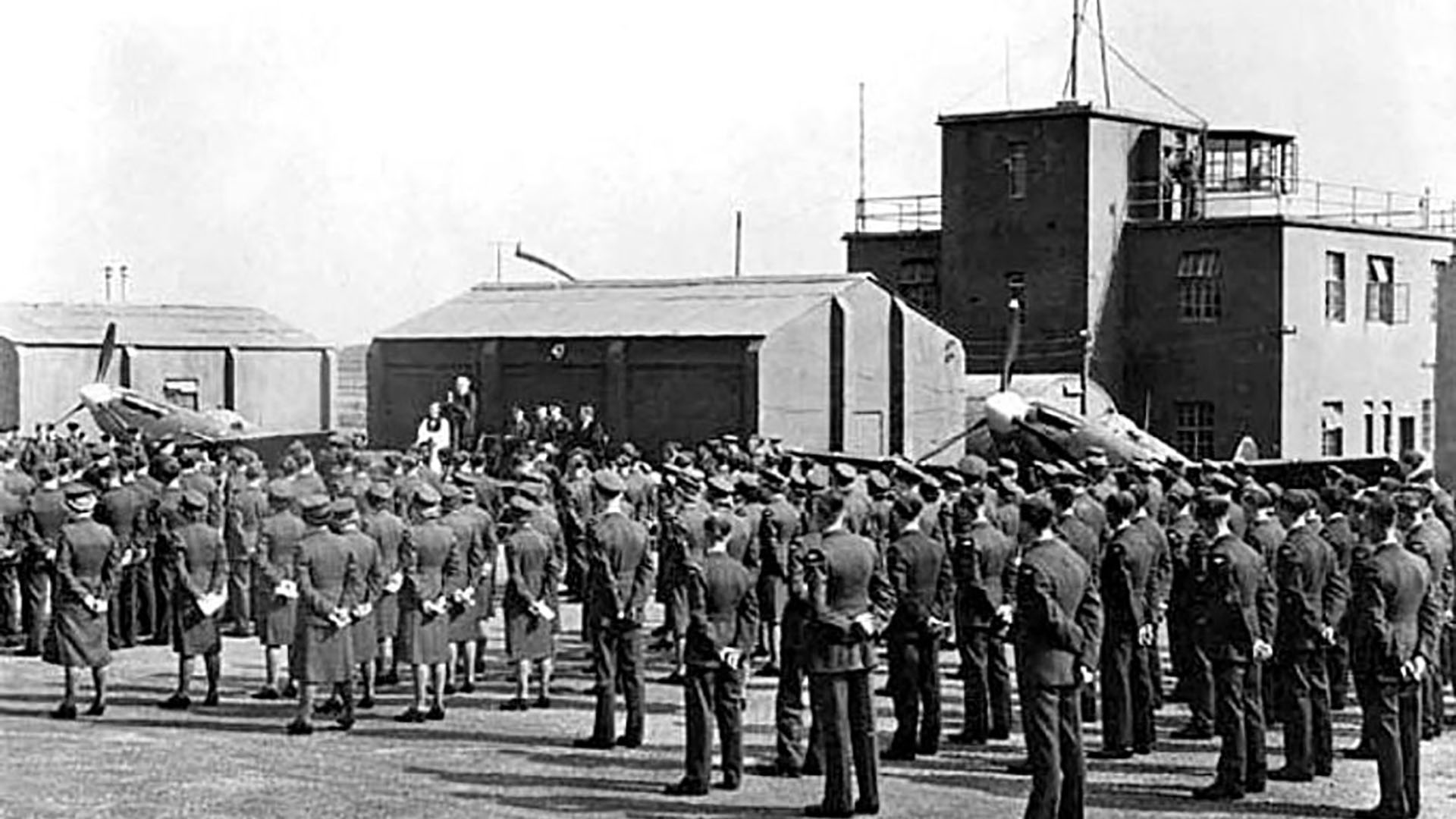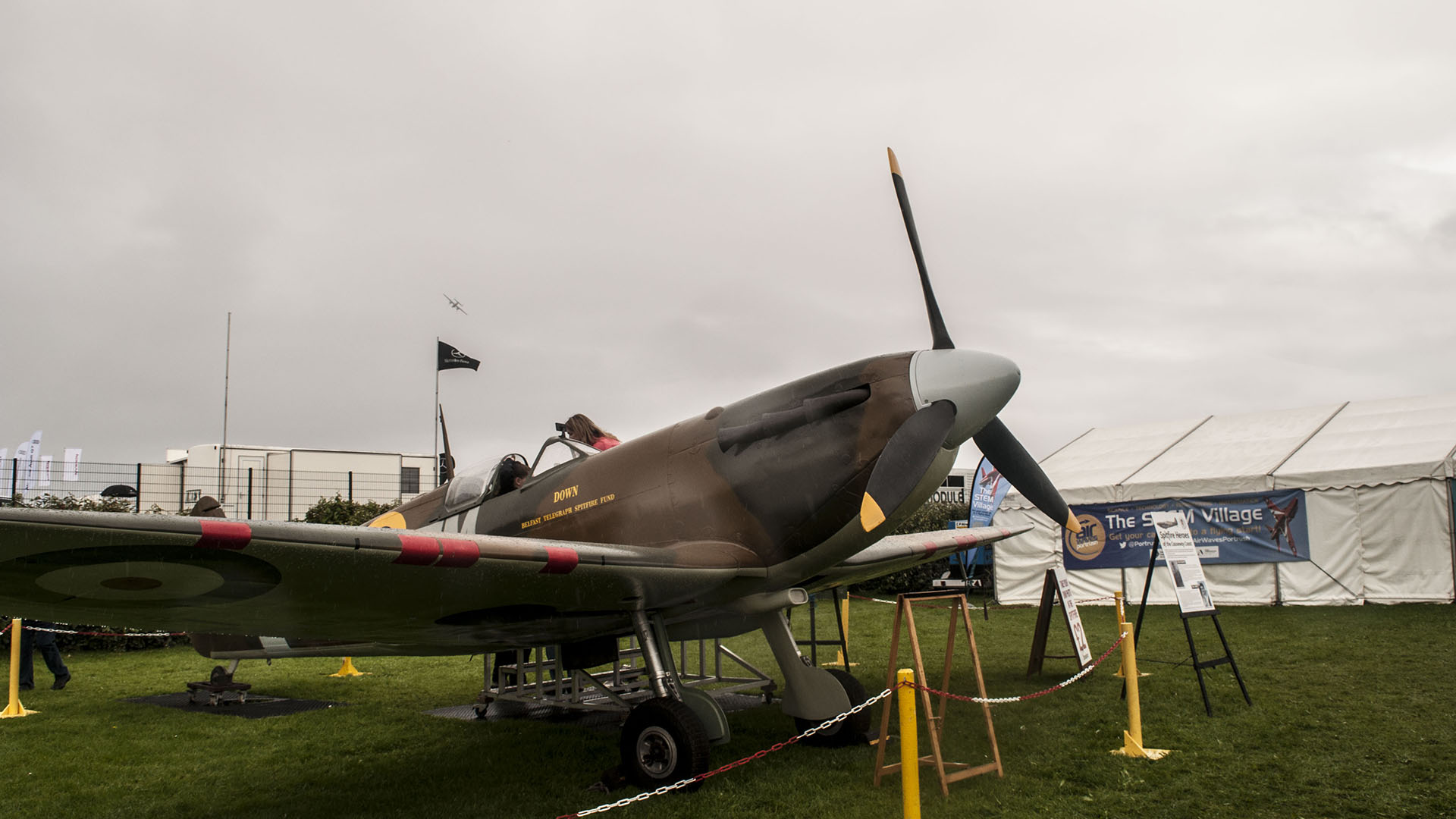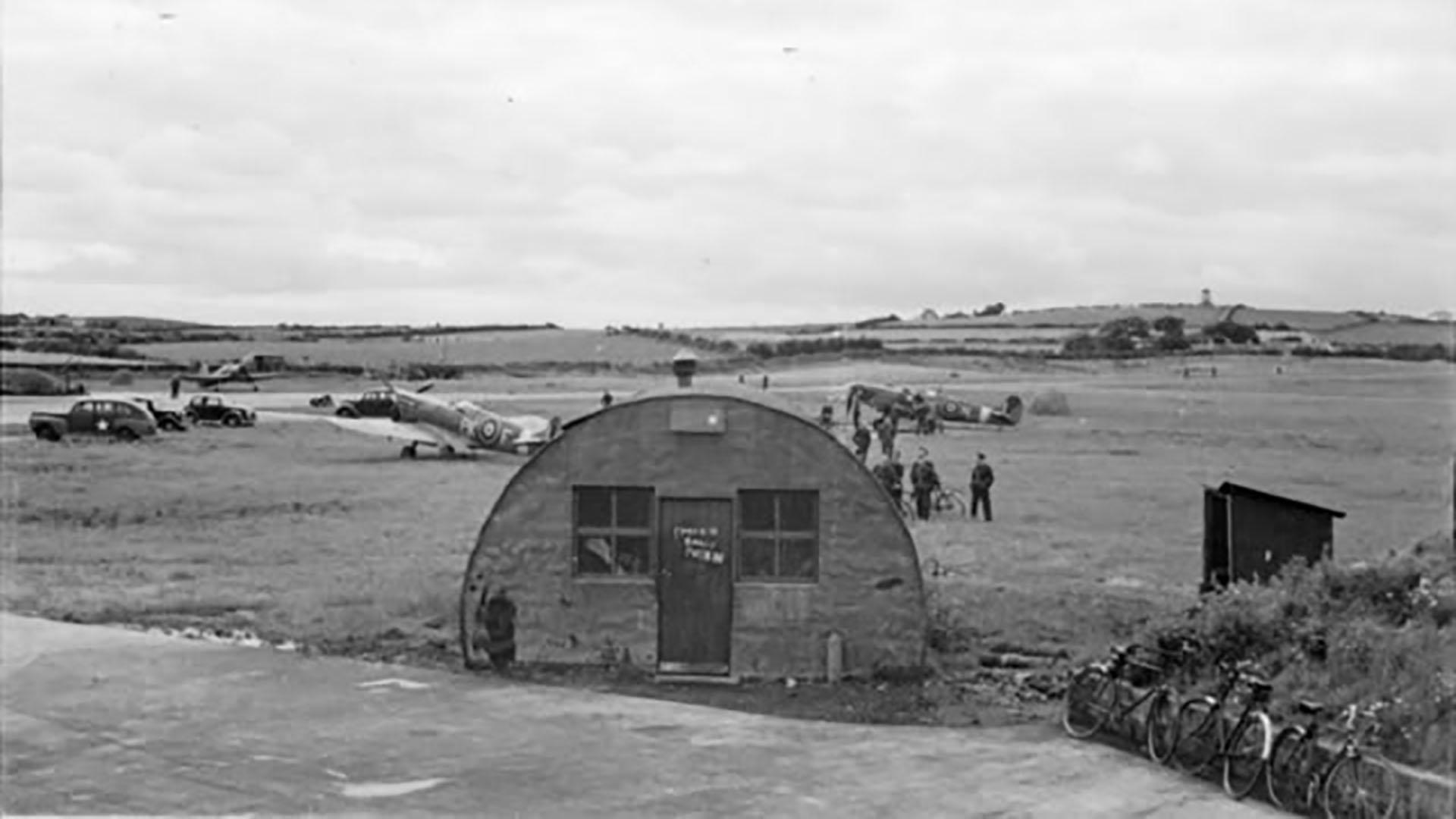Ballyhalbert Airfield also known as RAF Ballyhalbert, RNAS Ballyhalbert, and HMS Corncrake is on the Ards Peninsula, Co. Down. Near the town of Newtownards, the former airfield was approximately 32km east-south-east of Belfast.
Construction began on the airfield at Ballyhalbert in late 1940 and continued into early 1941. During the process, destruction of a historic windmill belonging to the Magilton family at Clydesburn took place.
Royal Air Force service began in May 1941 before completion of work on the Fighter Command airfield. The RAF held an official opening on 28th June 1941. The airfield featured 3 tarmac runways, 2 Bellman hangars, and 12 Blister hangars.
The first operational planes to fly from RAF Ballyhalbert were Hawker Hurricanes of RAF 245 Squadron on 14th July 1941. They came under the control of No. 15 Group and remained until 1st September 1941. With the transfer of Fighter Command No. 15 Group and RAF 245 Squadron to RAF Ballyhalbert, RAF Aldergrove, Crumlin, Co. Antrim became a Coastal Command base. A new Fighter Command unit, No. 82 Group formed in Northern Ireland in September 1941 based in the Senate Chamber, Stormont Buildings, Belfast.
RAF at Ballyhalbert Airfield
On 24th October 1941, RAF 153 Squadron reformed at RAF Ballyhalbert flying Boulton Paul Defiants. In May 1942, they switched to Bristol Beaufighters and remained in Co. Down until leaving for North Africa in December 1942.
On 26th October 1941, RAF 504 Squadron arrived at Ballyhalbert. They damaged 7 of their Hawker Hurricanes while landing in strong crosswinds. Soon after arriving, RAF 504 Squadron converted to Supermarine Spitfires. They remained at the Ballyhalbert airfield until 22nd January 1942 before moving on to the nearby RAF Kirkistown.
Crash of the "Down" Spitfire
On 7th January 1942 Pilot Officer Walter McManus of the Royal Canadian Air Force crashed on a routine flight from RAF St. Angelo, Co. Fermanagh to RAF Ballyhalbert, Co. Down. Flying with RAF 504 Squadron, his Belfast Telegraph funded “Down” Spitfire came down at Derrymacash, near Lurgan, Co. Armagh. His grave is in Ballycran Beg Churchyard near Ballyhalbert, Co. Down.
Night Fighters arrive in Co. Down
The departure of RAF 504 Squadron made way for RAF 25 (Night Fighter) Squadron in Bristol Beaufighters. This squadron had already downed many German bombers in British skies. They arrived on 24th January 1942 to combat the threat of enemy reconnaissance planes over Northern Ireland. Regular operations and consistent poor weather around the airfield lead to a lot of accidents and a drain of pilots.
On 9th February 1942, three planes from RAF 25 (Night Fighter) Squadron took off from RAF Kirkistown, a satellite of RAF Ballyhalbert. One ditched in a field near RAF West Freugh, Dumfries and Galloway, a second landed in a field near Ballyhalbert with only 6 gallons of fuel remaining. The third of the planes disappeared without trace. The body of pilot Sergeant Cannon washed ashore in a dingy in the Mull of Galloway, Scotland. He died of exposure despite extensive searches from Avro Anson planes from RAF West Freugh, Dumfries and Galloway. In mid-May 1942, RAF 25 (Night Fighter) Squadron left the airfield.
RAF 504 Squadron returned to the Co. Down airfield on 19th June 1942. That Autumn, USAAF 5 (Fighter) Squadron joined them in Supermarine Spitfires. 1493 Gunnery Flight also arrived at the airfield soon before RAF 504 Squadron once again left Ballyhalbert in October 1942. Their replacements on this occasion were RAF 501 Squadron operating a day defence fighters. They remained until 30th April 1943.
Downing a JU88
A scramble from RAF 504 Squadron on 23rd August 1942 resulted in Sergeant Francis downing JU88 (4U+KH) of 1(F)/123. He shared the victory with Pilot Officer Boleslaw Sawiak of RAF 315 Squadron based at RAF Valley, Anglesey, Wales and Flying Officer Sizzer of RAF 152 Squadron based at RAF Angle, Pembrokeshire, Wales. Blue and Green Sections of B Flight scrambled ay 0735hrs.
Francis attacked the JU88 in a 400mph dive causing it to take evasive action and stop returning fire. Hits caused damage to the Luftwaffe plane’s engines and cockpit. Sawiak scored several hits to the JU88 but broke away from combat, crashing at 0840hrs at Rathoath, Co. Meath. He died 2 hours later in St. Bricin’s Military Hospital, Dublin, Ireland. Authorities returned his body to England on the 1320hrs Dun Laoghaire ferry.
Sergeant Lisowski, wingman to Pilot Officer Sawiak of RAF 315 Squadron, diverted to RAF Ballyhalbert while running low on fuel. Meanwhile the JU88 continued south until coming under attack at 0900hrs from Flying Officer Sizzer and Flight Sergeant McPherson. It came down around 0920hrs at Carriglong, Tramore, Ireland. Hauptmann Gottfried Berndt, Leutnant Paul Stormer, Oberfeldwebel Karl Hund, and Unteroffizier Joseph Reiser were interned.
Polish Airmen at Ballyhalbert
By early 1943, conditions at the airfield had deteriorated. Heavy rain throughout the winter caused water to pour into many of the hastily constructed buildings. There were many complaints about the state of the site. On 30th April 1943, RAF 130 Squadron arrived with Supermarine Spitfires. They remained until 5th July 1943 when they traded places with RAF 315 (Polish) Squadron. RAF 26 Squadron joined the Poles at Ballyhalbert airfield on 19th July 1943 in Mustangs.
One VIP visitor to the airfield during this time was the Commander-in-Chief of Polish Armed Forces. General Kazimierz Sosnkowski arrived on 14th August 1943, meeting Polish pilots, and watching a flying display. He also presented the Cross of Virtuti Militari to Squadron Leader Sawicz, Flying Officer Blok, Squadron Leader Popawski, and Flying Officer Malczewski.
On 11th September 1943, three Supermarine Spitfires of RAF 315 Squadron took off from the Ballyhalbert airfield. The Polish airmen were Flight Sergeant Kolek, Flight Sergeant Zygmund, and Warrant Officer Grondowski. The three planes were on a practise formation flight.
They lost sight of each other in bad weather over Co. Antrim and all three Spitfires came down. Grondowski came down near Plantation House, Lisburn, Co. Antrim, Kolek crashed near Ballyutoag, Templepatrick, Co. Antrim, and Zygmund survived his crash at Glengormley, Co. Antrim. Warrant Officer Grondowski and Sergeant Kolek’s graves are in Ballycran Beg Churchyard, near Ballyhalbert, Co. Down.
In November 1943, RAF 315 Squadron left to join RAF 2nd Tactical Air Force. Another Polish outfit, RAF 303 Squadron, took their place at RAF Ballyhalbert, Co. Down. Night defence in November 1943 fell to another new arrival at Ballyhalbert, RAF 125 Squadron in Bristol Beaufighters.
February 1944 saw the arrival on 24 Fighter Wing, comprised of the Royal Navy’s Fleet Air Arm 887 and 894 Squadrons. The following two months saw RAF 125 Squadron, FAA 887 Squadron, and FAA 894 Squadron leave the airfield. Early March had seen the arrival of Fairey Fulmars of Fleet Air Arm 784 Squadron. The Polish airmen of RAF 303 Squadron left to join RAF 2nd Tactical Air Force on 30th April 1944.
Another high-profile visitor visited RAF Ballyhalbert around this time. General Dwight D Eisenhower made a stop at the Co. Down airfield on 19th May 1944 while en route to RAF Bovingdon, Hertfordshire.
Several other Squadrons used the Ballyhalbert airfield as a base between 30th May 1944 and April 1945.
In April 1945, control of the Ballyhalbert airfield transferred to the Admiralty and became a Royal Naval Air Station. RAF 1402 Meteorological Flight remained at the airfield. On 17th July 1945, the Admiralty commissioned RAF Ballyhalbert as HMS Corncrake. By 13th November 1945, decommissioning saw the site return to the control of RAF Coastal Command. The Royal Air Force managed the site until selling it at auction in March 1960.
During the conflict from 1939-1945, RAF, WAAF, USAAF, and Royal Navy personnel served at the Ballyhalbert airfield. In the nearby St. Andrew’s Church of Ireland lie the graves of Canadian, Australian, and Polish men who lost their lives in and around the airfield.
For many years after, the Ballyhalbert airfield was a popular spot for Northern Irish holidaymakers. The runways and perimeter track made a great location for a caravan park on the Ards Peninsula, Co. Down. By 2010, work had begun on creating several large housing developments meaning that little now remains of the airfield.
The name Ballyhalbert comes from the Irish Baile Thalboid, meaning “Talbot’s Townland”. The Talbot family settled in the area following John de Courcy’s 12th century conquest. Other historic sites in the Ballyhalbert area include an 800-year-old castle mound, a standing stone, and ruins of an old church.
Royal Air Force and Royal Navy at Ballyhalbert
The following units all operated from Ballyhalbert airfield between 1941 and 1946. If you have any further information on these squadrons, please get in touch.
| Force | Unit | Start Date | End Date | Planes Operated |
|---|---|---|---|---|
| Royal Air Force | No. 13 Group Anti Aircraft Cooperation Flight | May 1941 | November 1941 | |
| Royal Air Force | No. 245 Squadron | 14th July 1941 | 1st September 1941 | Hawker Hurricane |
| Royal Air Force | No. 81 Group Communications Flight | September 1941 | 5th January 1942 | |
| Royal Air Force | No. 153 Squadron | 24th October 1941 | 18th December 1942 | Boulton Paul Defiant / Bristol Beaufighter |
| Royal Air Force | No. 504 Squadron | 26th October 1941 | 22nd January 1942 | Hawker Hurricane / Supermarine Spitfire |
| Royal Air Force | No. 82 Group Target Towing Flight | 2nd November 1941 | 24th November 1941 | |
| Royal Air Force | No. 25 Squadron | 24th January 1942 | 16th May 1942 | Bristol Beaufighter |
| Royal Air Force | No. 504 Squadron | 19th June 1942 | 19th October 1942 | Supermarine Spitfire |
| Royal Air Force | No. 501 Squadron | 19th October 1942 | 30th April 1943 | |
| Royal Navy | No. 887 Naval Air Squadron | 19th October 1942 | 4th November 1942 | |
| Royal Air Force | No. 256 Squadron | 29th November 1942 | ||
| Royal Air Force | No. 130 Squadron | 30th April 1943 | 5th July 1943 | Supermarine Spitfire |
| Royal Air Force | No. 315 Squadron | 5th July 1943 | 13th November 1943 | Supermarine Spitfire |
| Royal Air Force | No. 26 Squadron | 19th July 1943 | 3rd March 1944 | North American Mustang I |
| Royal Air Force | No. 125 Squadron | November 1943 | 25th March 1944 | Bristol Beaufighter |
| Royal Air Force | No. 303 Squadron | 12th November 1943 | 30th April 1944 | Supermarine Spitfire |
| Royal Air Force | No. 63 Squadron | 26th April 1944 | 25th May 1944 | Hawker Hurricane |
| Royal Navy | No. 1840 Naval Air Squadron | 30th May 1944 | Grumman Hellcat | |
| Royal Air Force | No. 63 Squadron | 4th July 1944 | 29th August 1944 | Supermarine Spitfire |
| Royal Navy | No. 1840 Naval Air Squadron | October 1944 | October 1944 | Grumman Hellcat |
| Royal Navy | No. 1840 Naval Air Squadron | November 1944 | November 1944 | Grumman Hellcat |
| Royal Air Force | No. 1402 Meteorological Flight | 1st December 1944 | August 1945 | |
| Royal Navy | No. 812 Naval Air Squadron | 5th January 1945 | February 1945 | |
| Royal Navy | No. 1846 Naval Air Squadron | 13th January 1945 | 15th February 1945 | Chance Vought Corsair |
| Royal Navy | No. 3 Naval Fighter Wing (No. 808 Naval Air Squadron) | Supermarine Seafire | ||
| Royal Navy | No. 3 Naval Fighter Wing (No. 885 Naval Air Squadron) | Supermarine Seafire | ||
| Royal Air Force | No. 1480 Anti Aircraft Cooperation Flight | |||
| Royal Air Force | No. 1493 Target Towing Flight | |||
| Royal Air Force | No. 1494 Target Towing Flight | April 1945 | ||
| Royal Air Force | No. 2707 Squadron RAF Regiment | |||
| Royal Navy | No. 718 Naval Air Squadron | 17th August 1945 | 1st November 1945 | Supermarine Seafire / Supermarine Spitfire |
| Royal Navy | No. 725 Naval Air Squadron | Martinet | ||
| Royal Navy | No. 768 Naval Air Squadron | 28th August 1945 | 16th April 1946 | Supermarine Seafire |
| Royal Navy | No. 784 Naval Air Squadron | Fairey Fulmar | ||
| Royal Navy | No. 787 Naval Air Squadron | Supermarine Seafire | ||
| Royal Navy | No. 800 Naval Air Squadron | |||
| Royal Navy | No. 827 Naval Air Squadron | Fairey Barracuda | ||
| Royal Navy | No. 880 Naval Air Squadron | Supermarine Seafire | ||
| Royal Navy | No. 882 Naval Air Squadron | Grumman Wildcat | ||
| Royal Navy | No. 894 Naval Air Squadron | Supermarine Seafire | ||
| Royal Navy | No. 899 Naval Air Squadron | Supermarine Seafire / Supermarine Spitfire |



